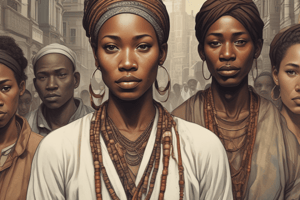Podcast
Questions and Answers
Which of the following describes a misconception about sexism in society?
Which of the following describes a misconception about sexism in society?
- Sexism can exist without being overtly visible. (correct)
- Sexism is only prevalent in non-Western countries.
- Sexism affects only women.
- Gender roles are universally accepted and unchallenged.
How does culture influence perceptions of gender roles?
How does culture influence perceptions of gender roles?
- Culture only reflects individual behaviors.
- Culture defines all aspects of gender identity.
- Culture has no impact on gender roles.
- Culture can reinforce or challenge existing gender norms. (correct)
What creates a barrier to recognizing sexism in society?
What creates a barrier to recognizing sexism in society?
- Focusing solely on individual acts rather than systemic issues. (correct)
- Acknowledging gender equality in all cultures.
- Encouraging mixed-gender interactions.
- Celebrating diversity in gender expression.
Which statement illustrates the concept of privilege in the context of education?
Which statement illustrates the concept of privilege in the context of education?
What is one way that sexism is concealed in Western societies?
What is one way that sexism is concealed in Western societies?
What underlies the normalization of gender roles in corporate culture?
What underlies the normalization of gender roles in corporate culture?
What is a key characteristic of deeper levels of culture?
What is a key characteristic of deeper levels of culture?
How can a teacher's prejudices lead to discrimination in the classroom?
How can a teacher's prejudices lead to discrimination in the classroom?
What is the main difference between discrimination and oppression?
What is the main difference between discrimination and oppression?
What does internalized dominance refer to?
What does internalized dominance refer to?
What concept suggests that knowledge is informed by cultural perspectives?
What concept suggests that knowledge is informed by cultural perspectives?
How can sexism manifest in educational settings?
How can sexism manifest in educational settings?
Which of the following exemplifies systemic oppression?
Which of the following exemplifies systemic oppression?
What role does the hidden curriculum play in education?
What role does the hidden curriculum play in education?
Which of the following describes privilege?
Which of the following describes privilege?
What is meant by the term 'positionality'?
What is meant by the term 'positionality'?
How can educators combat systemic inequalities in the classroom?
How can educators combat systemic inequalities in the classroom?
What defines 'internalized oppression'?
What defines 'internalized oppression'?
Which of the following is NOT a form of oppression?
Which of the following is NOT a form of oppression?
What is the effect of meritocracy in society?
What is the effect of meritocracy in society?
What is a critical aspect of critical thinking in education?
What is a critical aspect of critical thinking in education?
Flashcards are hidden until you start studying
Study Notes
Prejudice, Discrimination, and Oppression
- Prejudice: preconceived assumptions or stereotypes about social groups based on race, gender, ethnicity, religion, etc.
- Discrimination: acting on prejudiced notions.
- Oppression: a system of social inequality where certain groups are privileged at the expense of others.
- Prejudice + Power = Oppression: When a group's prejudice is backed by societal power, it leads to oppression.
- Internalized Dominance: The dominant group internalizes the idea of superiority and acts accordingly.
- Internalized Oppression: The minority group internalizes the idea of inferiority and accepts their social standing.
Social Justice and Systemic Inequality
- Systemic Inequality: Inequalities maintained by social institutions, such as education, government, workplace, media, etc.
- Examples: Teachers may believe boys are better at math than girls, or dress codes may target female students more than male students.
- Critical Thinking: Understanding that knowledge is constructed through social and political contexts.
Key Concepts in Critical Theory
- Critical Theory: Examines how society works and critiques social injustice.
- Shared Practices, Beliefs, and Values: Shape how individuals in society interact and behave.
- Hidden Curriculum: Teachers and schools instill societal norms, like respect for authority.
- Privilege: Unearned advantages that benefit certain groups over others.
- Social Class: Students’ social class influences the understanding of knowledge they acquire.
- Ideology: A set of beliefs and values that justify power structures in society.
- Individualism and Meritocracy: Ideologies that ignore systemic oppression and maintain social inequalities.
Sexism and Its Invisibility
- Sexism: Oppression based on gender, including gender violence and discrimination.
- Normalizing Gender Roles: Societal values like masculinity and femininity are reinforced by corporations and media.
- Western Culture and Sexism: Despite being seen as liberated, women in Western countries are still oppressed through gender norms, movies, ads, and music.
- Internalized Sexism: Women are socialized to believe that they have freedom and autonomy, even though they experience oppression.
Power Dynamics in Education
- Teachers and Power: Teachers often hold authority to implement instructional methods that align with their ideologies.
- Dominant Narratives: White knowledge is often privileged in education, leading to the oppression of marginalized students.
- Critical Teacher Reflection: Teachers must think critically about their biases and teaching methods to create just and equitable learning environments for diverse students.
Studying That Suits You
Use AI to generate personalized quizzes and flashcards to suit your learning preferences.




